Sony KDL-46HX705 User Manual [ru]

LCD TV
4-458-512-11(1)
Operating Instructions |
GB |
|
|
|
|
|
|
|
|
CS |
|
|
|
|
|
|
|
Mode d’emploi |
FR |
|
|
|
|
|
|
|
Инструкция по эксплуатации |
RU |
|
|
|
|
|
|
|
|
AR |
|
|
|
|
|
|
|
|
PR |
|
|
|
|
KDL-46R470A / 46R450A / 40R470A / 40R450A / 32R420A / 32R400A
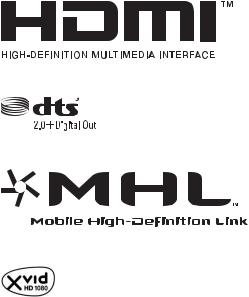
Introduction
Thank you for choosing this Sony product. Before operating the TV, please read this manual thoroughly and retain it for future reference.
The illustrations used in this manual are of the KDL-32R420A unless otherwise stated.
Trademark information
• is a registered trademark of the DVB Project.
is a registered trademark of the DVB Project.
•HDMI, the HDMI Logo, and High-Definition Multimedia Interface are trademarks or registered trademarks of HDMI Licensing, LLC in the United States and other countries.
•Manufactured under license from Dolby Laboratories.
•“BRAVIA” and 


 are trademarks of Sony Corporation.
are trademarks of Sony Corporation.
•MHL, Mobile High-Definition Link and the MHL Logo are trademarks or registered trademarks of MHL Licensing, LLC.
•Manufactured under license from DTS Licensing Limited. For U.S. and worldwide patent and trademark information, see www.dts.com/patents/legacy.aspx.
© DTS Licensing Limited and DTS, Inc. 2012.
Location of the identification label
Labels for Model No. and Power Supply rating (in accordance with applicable safety regulation) are located on the rear of the TV.
Notes for Australia and New Zealand model
This product is ENERGY RATING qualified in the “Home” mode. ENERGY RATING is a programme designed to promote energy efficient products and practices.
•When the TV is initially set up, it is designed to meet ENERGY RATING requirements while maintaining optimum picture quality.
•Changes to certain features, settings and
functionalities of this TV (e.g. TV Guide, Picture/Sound, Eco setting) can slightly change the power consumption.
Depending upon such changed settings (e.g. “Shop” mode), the power consumption may vary which possibly could exceed the stated energy rating.
To reset the TV to ENERGY RATING qualified settings, select “Home” mode from the initial setup procedure in “Factory Settings” under the “Set-up” menu.
IMPORTANT INFORMATION
If a television is not positioned in a sufficiently stable location, it can be potentially hazardous due to falling. Many injuries, particularly to children, can be avoided by taking simple precautions such as:
•Using cabinets or stands recommended by the manufacturer of the television.
•Only using furniture that can safely support the television.
•Ensuring the television is not overhanging the edge of the supporting furniture.
•Not placing the television on tall furniture (for example, cupboards or bookcases) without anchoring both the furniture and the television to a suitable support.
•Not standing the televisions on cloth or other materials placed between the television and supporting furniture.
•Educating children about the dangers of climbing on furniture to reach the television or its controls.
2 GB

Notice for customers in the South Africa
The Euro/South Africa converter plug should be fitted as follows.
1 Insert the power supply or CEE7 plug in to the converter plug.
2 Use an appropriate screwdriver
to attach the screw tightly |
|
|
without damaging the screw |
GB |
|
head. |
||
|
3 TEST: Grip the converter plug,
and pull the VDE cord set/ transformer to ensure it is fully secure, if not then increase the
torque setting and further tighten. Re-test.
The converter plug is now ready for use.
3 GB

Table of Contents
Start-up Guide |
|
Checking the accessories .................................. |
5 |
1: Attaching the Table-Top Stand....................... |
5 |
2: Connecting an antenna/cable/VCR ................ |
7 |
3: Preventing the TV from toppling over............. |
7 |
4: Performing the initial set-up............................ |
8 |
Watching TV....................................................... |
8 |
Safety information .............................................. |
9 |
Precautions ...................................................... |
10 |
Operating the TV |
|
Overview of the remote .................................... |
12 |
Overview of the TV buttons and indicators....... |
14 |
Using Optional Equipment |
|
Connecting optional equipment........................ |
15 |
Viewing pictures from the connected |
|
equipment......................................................... |
16 |
Connecting MHL device ................................... |
17 |
Viewing PIP (Picture in Picture)........................ |
17 |
Using Menu Functions |
|
Navigating through menus ............................... |
18 |
Using the Digital Programme List ........... |
19 |
Using the Digital Electronic Programme Guide |
|
(EPG) ............................................................... |
20 |
Playing back photo/music/video via USB......... |
21 |
Basic operation of Photo/Music/Video ............ |
21 |
Photo Frame |
|
(except KDL-46R450A/40R450A/32R400A) .... |
24 |
Listening to the FM Radio ................................ |
26 |
Using BRAVIA Sync with BRAVIA Sync |
|
Control.............................................................. |
27 |
BRAVIA Sync Control...................................... |
27 |
Settings adjustment.......................................... |
28 |
Picture ............................................................. |
28 |
Sound.............................................................. |
29 |
Screen............................................................. |
30 |
Channel Set-up ............................................... |
32 |
Parental Lock .................................................. |
34 |
Set-up.............................................................. |
35 |
Eco .................................................................. |
38 |
Additional Information |
|
Installing the accessories |
|
(Wall-Mount Bracket) ....................................... |
39 |
SU-WL400 ....................................................... |
41 |
TV installation dimensions table...................... |
42 |
Hook locations diagram/table ......................... |
43 |
Troubleshooting ............................................... |
44 |
Specifications................................................... |
46 |
 : for digital channels only
: for digital channels only
Before operating the TV, please read “Safety information” (page 9). Retain this manual for future reference.
4 GB
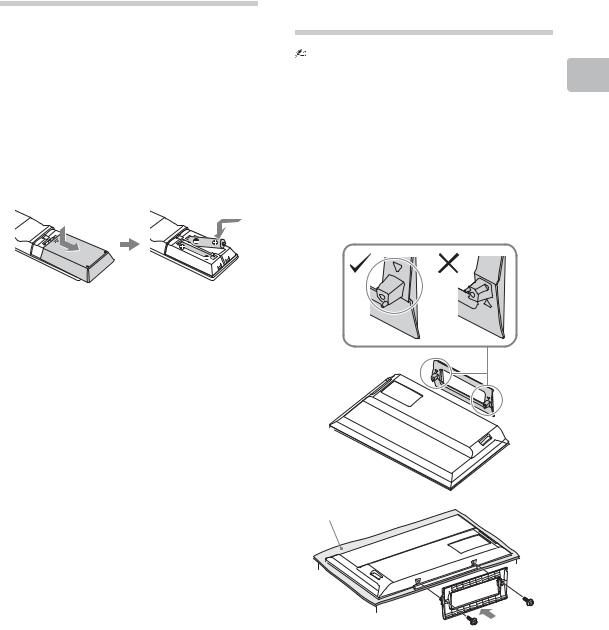
Checking the accessories
Table-Top Stand (1)
Fixing screws for Table-Top Stand (M5 × 16)
(2)
Attachment parts for Wall-Mount Bracket (2) (KDL-46R470A/46R450A only)
Fixing screws for Attachment parts (M4 × 12) (2) (KDL-46R470A/46R450A only)
Remote RM-ED054 (1)
Size AAA batteries (R03 type) (2)
x To insert batteries into the remote
Push to open
1:Attaching the Table-Top Stand
• Refer to the supplied Table-Top Stand instruction leaflet for proper attachment for some TV models.
• For best picture quality, do not expose the screen to direct illumination or sunlight.
1 |
Place the TV with its screen facing down on a |
-Start |
|
|
level and stable surface covered with a thick |
up |
|
|
and soft cloth. |
Guide |
|
2 |
Fix the TV to the Table-Top Stand using |
||
|
supplied screws.
x For KDL-46R450A/40R450A/32R400A
Thick and soft cloth
(Continued) |
5 GB |
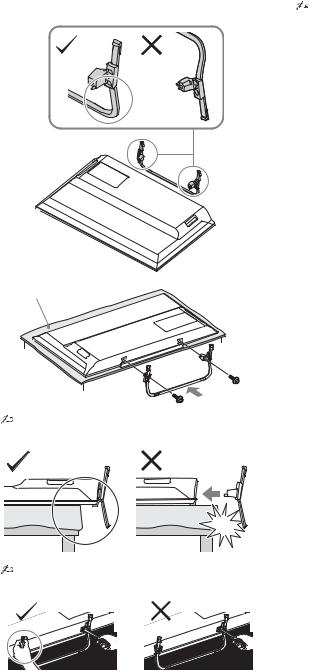
x For KDL-46R470A/40R470A/32R420A
Thick and soft cloth
• Be careful not to hit the Table-Top Stand against the edge of the surface when attaching it.
• Hold the Table-Top Stand with one hand to avoid it dropping when attaching.
•Do not put stress on the LCD panel or the frame around the screen.
•Be careful to not pinch your hands or the AC power cord when you install the TV set to the Table-Top Stand.
•This TV is very heavy, so two or more people should place the TV onto thick and soft cloth.
•If using an electric screwdriver, set the tightening torque at approximately 1.5 N·m (15 kgf·cm).
•Be sure to securely tighten the supplied screws, otherwise the TV may fall down.
•Use an appropriate screwdriver to attach the screws tightly without damaging the screw head.
•Please ensure the AC power cord is away from the stand installation location when you attach the Table-Top Stand.
•When detaching the Table-Top Stand, reverse the attaching procedure. Do not remove any screws other than those used when attaching the Tale-Top Stand. Do not power on the TV with its LCD panel facing down to avoid uneven picture uniformity.
6 GB
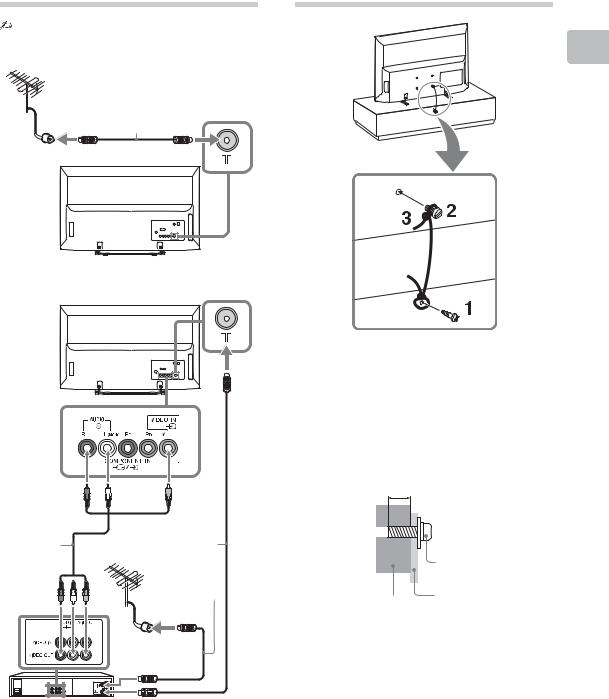
2: Connecting an |
3: Preventing the |
antenna/cable/ |
TV from |
VCR |
toppling over |
• Connecting cables are not supplied.
Connecting an antenna/cable
Antenna cable
Connecting an antenna/cable and VCR
Guide up-Start
AV cable |
Antenna cable |
Antenna cable
VCR
1 Install a wood screw (4 mm in diameter, not supplied) in the TV stand.
2 Install a machine screw (M4, not supplied) into the screw hole of the TV.
The length of the M4 machine screw differs depending on the cord diameter. Please refer to below illustration.
6-8 mm |
Screw M4
Cord
TV
3 Tie the wood screw and the machine screw with a strong cord (not supplied).
z• An optional Sony support belt kit is used to secure the TV. Contact your nearest Sony service centre to purchase a kit. Have your TV model name ready for reference.
7 GB
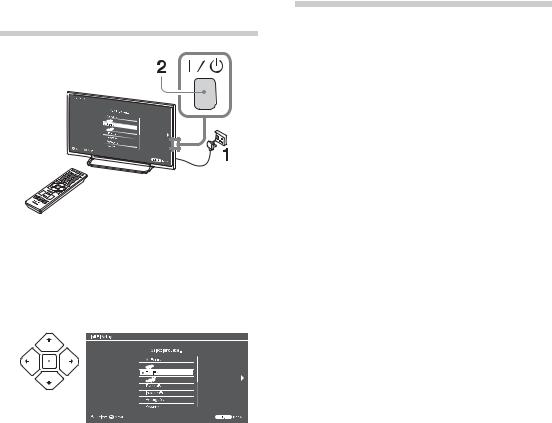
4: Performing the |
Watching TV |
|
initial set-up |
|
|
|
1 |
Press "/1 on the TV to turn on the TV. |
|
2 |
Press DIGITAL/ANALOG to switch between |
|
|
digital and analogue modes. |
|
3 |
Press the number buttons or PROG +/– to |
|
|
select a TV channel. |
|
4 |
Press VOLUME +/– to adjust the volume. |
1 The shapes of AC power plug and mains socket differ depending on the region.
2 When the TV is in standby mode (the "/1 indicator on the TV front panel is red), press "/1 on the remote to turn on the TV.
3
Follow the instructions on the screen:
•Set the language for the On Screen Display (OSD) text
•Select Region and Area
•Select the type of use
•Select “Home” for the best TV settings to use the TV in the home.
•Select broadcast.
•Scan for channels
•Change the order of channels
If you want to change the order of channels, follow the steps in “Programme Sorting” (page 33).
Press HOME or RETURN to exit. You can also tune channels manually (page 32).
• Set the current date and time (page 36).
8 GB
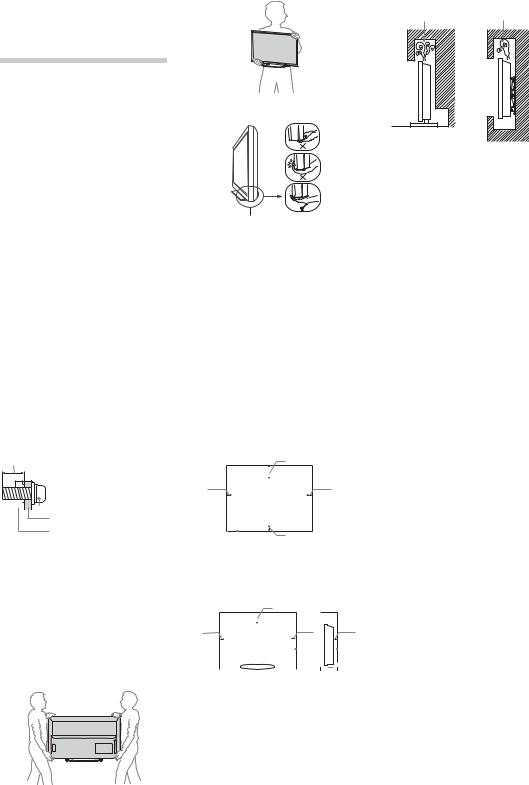
Safety information
Installation/Set-up
Install and use the TV set in accordance with the instructions below in order to avoid any risk of fire, electrical shock or damage and/or injuries.
Installation
•The TV set should be installed near an easily accessible mains socket.
•Place the TV set on a stable, level surface to avoid it from falling down and cause personal injury or damage to the TV.
•Only qualified service personnel should carry out wall installations.
•For safety reasons, it is strongly recommended that you use Sony accessories, including:
– Wall-mount bracket SU-WL400
•Be sure to use the screws supplied with the Wall-mount bracket when attaching the mounting hooks to the TV set. The supplied screws are designed as indicated by illustration when measured from the attaching surface of the mounting hook.
The diameter and length of the screws differ depending on the Wallmount bracket model.
Use of screws other than those supplied may result in internal damage to the TV set or cause it to fall, etc.
32''/40'': 6.5~10mm 46'': 8~12mm
Screw (supplied with the
Wall-mount bracket)
32''/40'': M4




 46'': M6 Mounting Hook
46'': M6 Mounting Hook
Hook attachment on rear of TV set
Transporting
•Before transporting the TV set, disconnect all cables.
•Two or more people are needed to transport a large TV set.
•When transporting the TV set by hand, hold it as shown below. Do not put stress on the LCD panel and the frame around the screen.
KDL-46R470A/46R450A/40R470A/ 40R450A
KDL-32R420A/32R400A
•When lifting or moving the TV set, hold it firmly from the bottom.
–Do not install the TV set as shown below.
Air circulation is blocked.
Wall |
Wall |
Be sure to hold the bottom of the panel, not the front part.
•When transporting the TV set, do not subject it to jolts or excessive vibration.
•When transporting the TV set for repairs or when moving, pack it using the original carton and packing material.
Ventilation
•Never cover the ventilation holes or insert anything in the cabinet.
•Leave space around the TV set as shown below.
•It is strongly recommended that you use a Sony wall-mount bracket in order to provide adequate aircirculation.
Installed on the wall
|
|
|
|
|
|
|
30 cm |
||||||||||
10 cm |
|
|
|
|
|
|
|
|
|
10 cm |
|||||||
|
|
|
|
|
|
|
|
|
|
|
|
|
|
|
|
|
|
|
|
|
|
|
|
|
|
|
|
|
|
|
|
|
|
|
|
|
|
|
|
|
|
|
10 cm |
||||||||||
|
|
|
|
|
|
||||||||||||
Leave at least this space around |
|||||||||||||||||
the set. |
|
|
|
|
|
|
|
|
|
|
|
|
|
|
|||
Installed with stand |
|||||||||||||||||
|
|
|
|
|
|
30 cm |
|||||||||||
10 cm |
|
|
|
|
|
|
|
10 cm |
|
6 cm |
|||||||
|
|
|
|
|
|
|
|
|
|||||||||
|
|
|
|
|
|
|
|
|
|
|
|
|
|
|
|
|
|
|
|
|
|
|
|
|
|
|
|
|
|
|
|
|
|
|
|
|
|
|
|
|
|
|
|
|
|
|
|
|
|
|
|
|
|
|
|
|
|
|
|
|
|
|
|
|
|
|
|
|
|
|
|
Leave at least this space around the set.
•To ensure proper ventilation and prevent the collection of dirt or dust:
–Do not lay the TV set flat, install upside down, backwards, or sideways.
–Do not place the TV set on a shelf, rug, bed or in a closet.
–Do not cover the TV set with a cloth, such as curtains, or items such as newspapers, etc.
AC power cord
Handle the AC power cord and outlet as follows in order to avoid any risk of fire, electrical shock or damage and/or injuries:
–The shape of AC power plug, which is supplied with the TV set, varies depending on the regions. Be sure to connect the appropriate supplied AC power cord with the plug that fits into the mains socket.
–Use only Sony supplied AC power cords, not those of other brands.
–Insert the plug fully into the mains socket.
–Operate the TV set on a 110-240 V AC supply only.
–When wiring cables, be sure to unplug the AC power cord for your safety and take care not to catch your feet on the cables.
–Disconnect the AC power cord from the mains socket before working on or moving the TV set.
–Keep the AC power cord away from heat sources.
–Unplug the AC power plug and clean it regularly. If the plug is covered with dust and it picks up moisture, its insulation may deteriorate, which could result in a fire.
Notes
•Do not use the supplied AC power cord on any other equipment.
•Do not pinch, bend, or twist the AC power cord excessively. The core conductors may be exposed or broken.
•Do not modify the AC power cord.
•Do not put anything heavy on the AC power cord.
•Do not pull on the AC power cord itself when disconnecting the AC power cord.
•Do not connect too many appliances to the same mains socket.
•Do not use a poor fitting mains socket.
Prohibited Usage
Do not install/use the TV set in locations, environments or situations such as those listed below, or the TV set may malfunction and cause a fire, electrical shock, damage and/or injuries.
(Continued) |
9 GB |

Location:
•Outdoors (in direct sunlight), at the seashore, on a ship or other vessel, inside a vehicle, in medical institutions, unstable locations, near water, rain, moisture or smoke.
•If the TV is placed in the changing room of a public bath or hot spring, the TV may be damaged by airborne sulfur, etc.
Cleaning:
Do not spray water or detergent directly on the TV set. It may drip to the bottom of the screen or exterior parts and get inside, resulting in a malfunction.
Environment:
•Places that are hot, humid, or excessively dusty; where insects may enter; where it might be exposed to mechanical vibration, near flammable objects (candles, etc). The TV set shall not be exposed to dripping or splashing and no objects filled with liquids, such as vases, shall be placed on the TV.
•Do not place the TV in a humid or dusty space, or in a room with oily smoke or steam (near cooking tables or humidifiers). Fire, electric shock, or warping may result.
Situation:
•Do not use when your hands are wet, with the cabinet removed, or with attachments not recommended by the manufacturer. Disconnect the TV set from mains socket and antenna during lightning storms.
•Do not install the TV so that it sticks out into an open space. Injury or damage from a person or object bumping into the TV may result.
Broken pieces:
•Do not throw anything at the TV set. The screen glass may break by the impact and cause serious injury.
•If the surface of the TV set cracks, do not touch it until you have unplugged the AC power cord. Otherwise electric shock may result.
•Do not subject the LCD screen to any strong impact or shock. The screen glass may crack or shatter and cause injury.
When not in use
•If you will not be using the TV set for several days, the TV set should be disconnected from the AC power for environmental and safety reasons.
•As the TV set is not disconnected from the mains socket when the TV set is just turned off, pull the plug from the mains socket to disconnect the TV set completely.
•However, some TV sets may have features that require the TV set to be left in standby to work correctly.
For children
•Do not allow children to climb on the TV set.
•Keep small accessories out of the reach of children, so that they are not mistakenly swallowed.
If the following problems occur...
Turn off the TV set and unplug the AC power cord immediately if any of the following problems occur.
Ask your dealer or Sony service centre to have it checked by qualified service personnel.
When:
–AC power cord is damaged.
–Poor fitting of mains socket.
–TV set is damaged by being dropped, hit or having something thrown at it.
–Any liquid or solid object falls through openings in the cabinet.
About LCD Monitor Temperature
When the LCD Monitor is used for an extended period, the panel surrounds become warm. You may feel hot when touching there by the hand.
Precautions
Viewing the TV
•View the TV in moderate light, as viewing the TV in poor light or during long period of time, strains your eyes.
•When using headphones, adjust the volume so as to avoid excessive levels, as hearing damage may result.
LCD Screen
•Although the LCD screen is made with high-precision technology and 99.99% or more of the pixels are effective, black dots may appear or bright points of light (red, blue, or green) may appear constantly on the LCD screen. This is a structural property of the LCD screen and is not a malfunction.
•Do not push or scratch the front filter, or place objects on top of this TV set. The image may be uneven or the LCD screen may be damaged.
•If this TV set is used in a cold place, a smear may occur in the picture or the picture may become dark. This does not indicate a failure. These phenomena disappear as the temperature rises.
•Ghosting may occur when still pictures are displayed continuously. It may disappear after a few moments.
•The screen and cabinet get warm when this TV set is in use. This is not a malfunction.
•The LCD screen contains a small amount of liquid crystal. Some fluorescent tubes used in this TV set also contain mercury (except for LED backlight LCD TV). Follow your local ordinances and regulations for disposal.
Handling and cleaning the screen surface/cabinet of the TV set
Be sure to unplug the AC power cord connected to the TV set from mains socket before cleaning.
To avoid material degradation or screen coating degradation, observe the following precautions.
•To remove dust from the screen surface/cabinet, wipe gently with a soft cloth. If dust is persistent, wipe with a soft cloth slightly moistened with a diluted mild detergent solution.
•Do not spray water or detergent directly on the TV set. It may drip to the bottom of the screen or exterior parts, and may cause a malfunction.
•Never use any type of abrasive pad, alkaline/acid cleaner, scouring powder, or volatile solvent, such as alcohol, benzene, thinner or insecticide. Using such materials or maintaining prolonged contact with rubber or vinyl materials may result in
10 GB

damage to the screen surface and cabinet material.
•Periodic vacuuming of the ventilation openings is recommended to ensure to proper ventilation.
•When adjusting the angle of the TV set, move it slowly so as to prevent the TV set from moving or slipping off from its table stand.
Optional Equipment
Keep optional components or any equipment emitting electromagnetic radiation away from the TV set. Otherwise picture distortion and/or noisy sound may occur.
Caution about handling the remote control and batteries
Notes
•Observe the correct polarity when inserting batteries.
•Do not use different types of batteries together or mix old and new batteries.
•Dispose of batteries in an environmentally friendly way. Certain regions may regulate the disposal of batteries. Please consult your local authority.
•Handle the remote with care. Do not drop or step on it, or spill liquid of any kind onto it.
•Do not place the remote in a location near a heat source, a place subject to direct sunlight, or a damp room.
WARNING
Batteries must not be exposed to excessive heat such as sunshine, fire or the like.
Disposal of the TV set
Disposal of Old Electrical & Electronic
Equipment (Applicable in
the European Union and other
European countries with separate collection systems)
This symbol is on the remote control.
11 GB
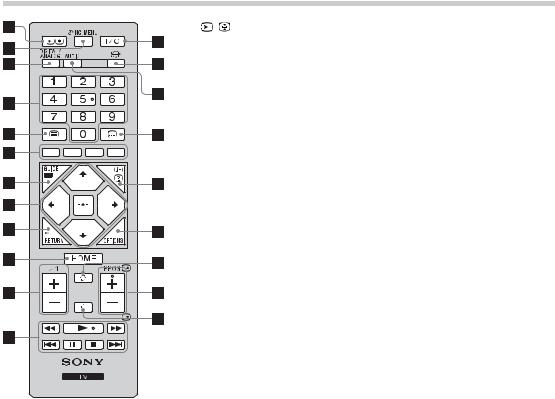
Overview of the remote
z• The number 5, N,
PROG + and AUDIO buttons have tactile dots. Use the tactile dots as references when operating the TV.
1 |
|
/ – Input select / Text hold |
|
• |
Displays the connected equipment list and selects the input source |
|
|
(page 16). |
|
• |
In Text mode: Holds the current page. |
2SYNC MENU
Press to display the BRAVIA Sync Menu and then select connected HDMI/MHL equipment from “Device Selection”.
The following options can be selected from BRAVIA Sync Menu: “Device Control”: Use the “Device Control” menu to operate equipment that is compatible with BRAVIA Sync Control. Select options from “Home (Menu)”, “Options” and “Content List” to operate the equipment.
“Speakers”: Selects “TV Speakers” or “Audio System” to output the TV’s sound from the TV speakers or connected audio equipment. “TV Control”: Use the “TV Control” menu to operate the TV from the “Home (Menu)” or “Options” menu.
“Return to TV”: Selects this option to return to TV programme.
3DIGITAL/ANALOG
Press to switch between digital and analogue mode.
4Number buttons
•Selects channels. For channel numbers 10 and above, enter the next digit quickly.
•In Text mode: Enters the three digit page number to select the page.
5/ – Text
In Text mode: Displays Text broadcast.
Each time you press /, the display changes cyclically as follows: Text t Text over the TV picture (mix mode) t No Text (exit the Text service)
6Coloured buttons
When the coloured buttons are available, an operation guide appears on the screen.
7  GUIDE (EPG)
GUIDE (EPG)
Press to display the Digital Electronic Programme Guide (EPG) (page 20).
8F/f/G/g/ – Item select / Enter
– Item select / Enter
•Selects or adjusts items.
•Confirms selected items.
•When playing a photo file: Press G to select the previous file. Press g
to select the next file.
When playing a music/video file: Press  to pause/start the playback. Press and hold G/g to fast forward/fast reverse, then release the button at the point where you want to resume playback.
to pause/start the playback. Press and hold G/g to fast forward/fast reverse, then release the button at the point where you want to resume playback.
•In digital mode: Press  to add channel to the empty Favourite list or display Favourite list.
to add channel to the empty Favourite list or display Favourite list.
9  RETURN
RETURN
•Returns to the previous screen of any displayed menu.
•When playing a photo/music/video file: Press to stop the playback (the display returns to the file or thumbnail view).
q; HOME
Displays or cancels the menu.
qa 2 +/– – Volume
Adjusts volume.
qs ./X/x/>/m/N/M
You can operate the BRAVIA Sync-compatible equipment that is connected to the TV. Some other buttons on the remote control may also operate BRAVIA Sync equipment.
qd "/1 – TV standby
Press to turn the TV on or to switch to standby mode.
12 GB
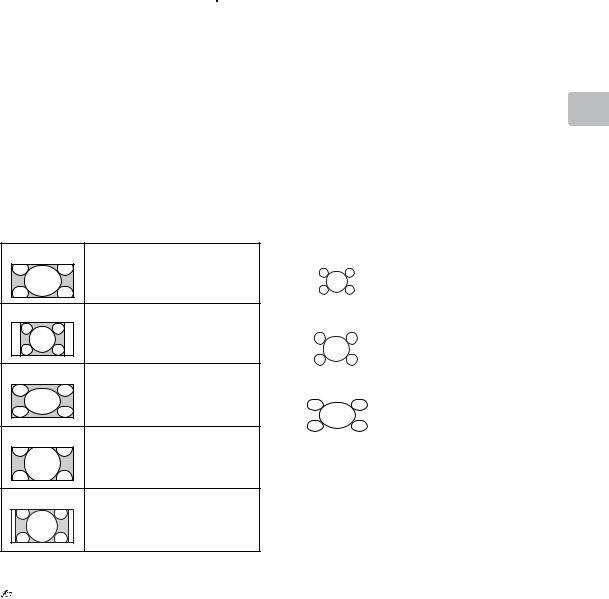
qf  – Wide Mode
– Wide Mode
Changes the picture size. Press repeatedly to select the desired wide mode (page 13).
qg AUDIO – Dual Sound (page 30) qh  – Subtitle setting
– Subtitle setting
Press to change the subtitle language (page 33) (in digital mode only). qj  /
/ – Info / Text reveal
– Info / Text reveal
•Displays information. Press once to display information about the programme/input you are viewing. Press again to remove the display from the screen.
•In Text mode: Reveals hidden information (e.g. answers to a quiz).
qk OPTIONS
Press to display a list that contains shortcuts to some setting menus. The listed options vary depending on the current input and content.
ql  – Previous channel
– Previous channel
Returns to the previous channel or input watched (for more than 15 seconds).
w; PROG +/–/ /
/
•Selects the next (+) or previous (–) channel.
•In Text mode: Selects the next ( ) or previous (
) or previous ( ) page. wa % – Mute
) page. wa % – Mute
Press to mute the sound. Press again to restore the sound.
x To change the Wide Mode
For TV, Video, Component or HDMI/MHL
Wide Zoom* |
Enlarges the centre portion of the |
|
picture. The left and right edges |
|
of the picture are stretched to fill |
|
the 16:9 screen. |
Normal |
Displays the 4:3 picture in its |
|
original size. Side bars are shown |
|
to fill the 16:9 screen. |
Full |
Stretches the 4:3 picture |
|
horizontally to fill the 16:9 screen. |
Zoom* |
Displays cinemascopic (letter box |
|
format) broadcasts in the correct |
|
proportions. |
14:9* |
Displays 14:9 broadcasts in the |
|
correct proportions. As a result, |
|
black border areas are visible on |
|
the screen. |
HDMI PC Input (PC timing)
Normal |
Displays the picture in its original |
||||
|
|
|
|
|
pixel size. Bars are shown at the |
|
|
|
|
|
top, bottom, and both sides for |
|
|
|
|
|
small picture. |
|
|
|
|
|
|
|
|
|
|
|
|
Full 1 |
Stretches the original picture to fill |
||||
|
|
|
|
|
the screen vertically, keeping its |
|
|
|
|
|
original horizontal-to-vertical |
|
|
|
|
|
aspect ratio. |
|
|
|
|
|
|
Full 2 |
Stretches the Full 1 picture |
||||
|
|
|
|
|
horizontally to fill the 16:9 screen. |
|
|
|
|
|
|
|
|
|
|
|
|
*Parts of the top and bottom of the picture may be cut off.
• You cannot select “Normal” or “14:9” for HD signal source pictures.
TV the Operating
13 GB
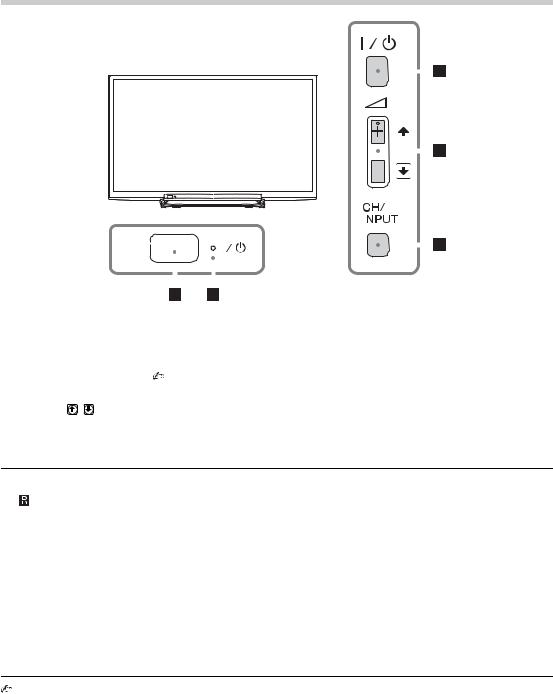
Overview of the TV buttons and indicators
|
|
|
|
|
|
|
|
|
|
|
|
|
|
|
|
|
|
|
|
|
|
|
|
|
|
|
|
|
|
|
|
|
|
|
|
|
|
|
|
|
|
|
|
|
|
|
|
|
|
|
|
|
|
|
|
|
|
|
|
|
|
|
|
|
|
|
|
|
|
|
|
|
|
|
|
|
|
|
|
|
|
|
|
|
|
|
|
|
|
|
|
|
|
|
|
|
|
|
|
|
|
|
|
|
|
|
|
|
|
|
|
|
|
|
|
|
|
|
|
|
|
|
|
|
|
|
|
|
|
|
|
|
|
|
|
|
|
|
|
|
|
|
|
|
|
|
|
|
|
|
|
|
|
|
|
|
|
|
|
|
|
|
|
|
|
|
|
|
|
|
|
|
|
|
|
|
|
|
|
|
|
|
|
|
|
|
|
|
|
|
|
|
|
|
|
|
|
|
|
|
|
|
|
|
|
|
|
|
|
|
|
|
|
|
|
|
|
|
|
|
|
|
|
|
|
|
|
|
|
|
|
|
|
|
|
|
|
|
|
|
|
|
|
|
|
|
|
|
|
|
|
|
|
|
|
|
|
|
|
|
|
|
|
|
|
|
|
|
|
|
|
|
|
|
|
|
|
|
|
|
|
|
|
|
|
|
|
|
|
|
|
|
|
|
|
|
|
|
|
|
|
|
|
|
|
|
|
|
|
|
|
|
|
|
|
|
|
|
|
|
|
|
|
|
|
|
|
|
|
|
|
|
|
|
|
|
|
|
|
|
|
|
|
|
|
|
|
|
|
|
|
|
|
|
|
|
|
|
|
|
|
|
|
|
|
|
|
|
|
|
|
|
|
|
|
|
|
|
|
|
|
|
|
|
|
|
|
|
|
|
|
|
|
|
|
|
|
|
|
|
|
|
|
|
|
|
|
|
|
|
|
|
|
|
|
|
|
|
|
|
|
|
|
|
|
|
|
|
|
|
|
|
|
|
|
|
|
|
|
|
|
|
|
|
|
|
|
Item |
|
Description |
|||||||||||||||||||||||||
1 |
"/1 |
|
|
|
|
|
– Power |
||||||||||||||||||||
|
|
|
|
|
|
|
Press to turn the TV on or to switch to standby mode. |
||||||||||||||||||||
|
|
|
|
|
|
|
|
|
• To disconnect the TV from the AC power completely, pull the plug from the |
||||||||||||||||||
|
|
|
|
|
|
|
|
|
|
|
|
mains socket. |
|||||||||||||||
|
|
|
|
|
|
|
|
|
|
|
|
|
|
|
|
|
|
|
|
|
|
|
|
|
|
|
|
2 |
2 + / – / |
|
/ |
|
|
|
• Increases/decreases the volume, or selects the next (+) or previous (–) |
||||||||||||||||||||
|
|
|
|||||||||||||||||||||||||
|
|
|
|
|
|
|
|
channel when the CH Up/Down screen is displayed by pressing the CH/ |
|||||||||||||||||||
|
|
|
|
|
|
|
|
INPUT button. |
|||||||||||||||||||
•Moves the selected input source up/down when the input select screen is displayed by pressing the CH/INPUT button.
3 CH/INPUT |
Switches between the CH Up/Down screen and input select screen. |
|
|
4 |
– Remote sensor |
|
Receives IR signals from the remote. |
|
Do not put anything over the sensor, doing so may affect its function. |
|
|
5 "/1 |
– Picture Off / Timer indicator |
|
• Lights up in orange when this sleep timer is set (page 36) or the TV is in Photo |
|
Frame Mode (page 24). |
|
• Lights up in green when the “Power Saving” is set to “Picture Off” (page 38). |
– Standby indicator
Lights up in red when the TV is in standby mode.
– Power indicator
•Lights up in green when the TV is turned on.
•Flashes while the remote is being operated.
• Make sure that the TV is completely turned off before unplugging the AC power cord. Unplugging the AC power cord while the TV is turned on may cause the indicator to remain lit or may cause the TV to malfunction.
z • The 2 + button has a tactile dot. Use it as a reference when operating the TV.
14 GB
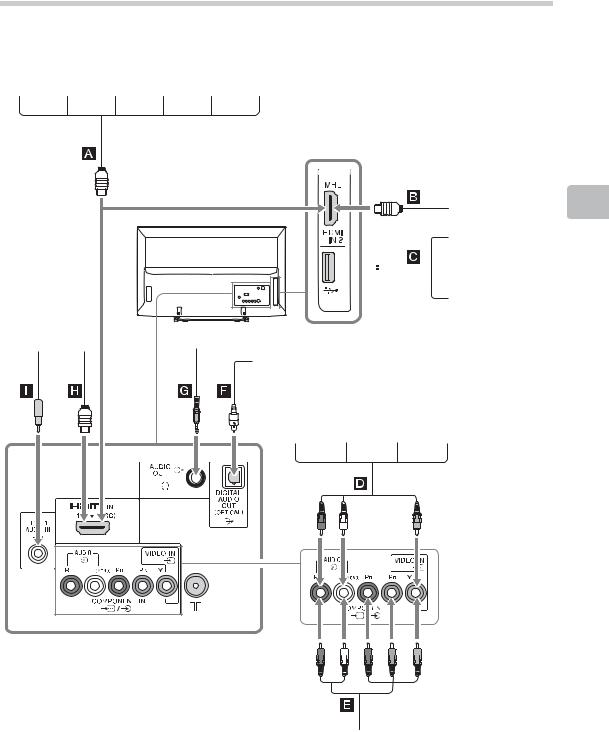
Connecting optional equipment
You can connect a wide range of optional equipment to your TV.
|
|
DVD |
|
|
Home |
|
player |
PC |
Blu-ray |
|
with |
|||
theatre |
Audio |
HDMI |
(HDMI- |
Disc |
system* |
system |
Camcorder output |
output) |
player |
MHL device
Digital still camera







 Camcorder
Camcorder
|
|
|
|
USB storage |
|
|
|
|
media |
DVI-output |
Headphones/Hi-Fi audio |
|
|
|
equipment |
equipment |
|
|
|
|
Hi-Fi audio equipment with |
|
|
|
|
optical audio input |
|
|
|
|
S VHS/ |
Video |
DVD |
|
|
Hi8/DVC |
game |
|
|
|
camcorder |
equipment |
player |
VCR |
DVD player with component output
*To output the TV’s sound from the TV speakers, connect the TV’s Audio out with Home theatre system’s Line-in using an audio cable.
Equipment Optional Using
15 GB
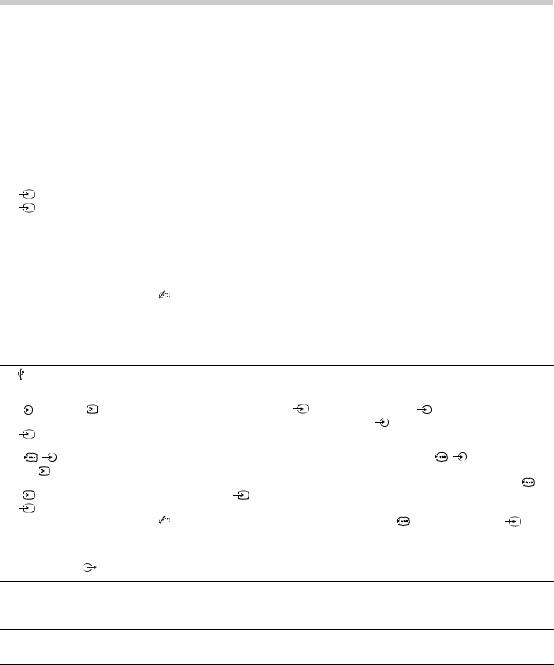
Viewing pictures from the connected equipment
Turn on the connected equipment, then press  /
/ to display the connected equipment list. Press F/ f to select the desired input source, then press
to display the connected equipment list. Press F/ f to select the desired input source, then press  . (The highlighted item is selected if 2 seconds pass without any operation after pressing F/f.)
. (The highlighted item is selected if 2 seconds pass without any operation after pressing F/f.)
z• You can select A, B, D, E and H by Input Select. If you want select the other input, please press HOME and select correctly.
Jacks/ |
Description |
Input symbol on screen |
|
|
|
A, B, H |
Connect to the HDMI IN 1 or 2 jack if the equipment has an HDMI jack. The |
HDMI IN 1 (ARC) |
digital video and audio signals are input from the equipment. |
HDMI IN 2/MHL |
In addition, when you connect the equipment that is compatible with BRAVIA |
HDMI 1 or |
Sync Control, communication with the connected equipment is supported. See |
page 37 to set up this communication. |
|
HDMI 2 |
You can also connect your MHL (Mobile High-Definition Link) device to HDMI |
|
IN 2/MHL using an MHL cable. In addition, when you connect BRAVIA Sync- |
|
compatible equipment, communication with the connected device is |
|
supported. |
|
If connecting a digital audio system that is compatible with Audio Return |
|
Channel (ARC) technology, use HDMI IN 1 (ARC). If not, an additional |
|
connection with DIGITAL AUDIO OUT (OPTICAL) is necessary. |
|
• The HDMI jacks only support the following video inputs: 480i, 480p, 576i, |
|
576p, 720p, 1080i, 1080p and 1080/24p. |
•The HDMI jacks can support PC timing in HDMI PC mode. See page 31 for supported PC input signal.
•Be sure to use only an authorized HDMI cable bearing the HDMI logo. We recommend that you use a Sony HDMI cable (high speed type).
C |
|
|
You can enjoy photo/music/video files stored in a Sony digital still camera, |
||||||||||||
|
|
|
|
|
camcorder or USB storage device (page 21). |
|
|
|
|
|
|
||||
|
|
|
|
|
|
|
|
|
|
|
|
|
|||
D |
AUDIO/ |
VIDEO IN Connect to the video jack |
and the audio jacks |
|
. If you connect mono |
||||||||||
|
|
|
Video |
|
equipment, connect to the L (MONO) jack . |
|
|
|
|
|
|
||||
|
|
|
|
|
|
|
|
|
|
|
|
|
|
|
|
|
|
|
|
|
|
|
|
|
|
|
|||||
E |
|
|
/ COMPONENT IN Connect to the component jacks and the audio jacks |
|
/ . For better |
|
|||||||||
|
|
|
|
||||||||||||
or |
VIDEO IN |
picture quality, component connection is recommended if your DVD player |
|||||||||||||
|
|
|
Component or |
has a component video output. When using the component video jack |
|
|
as |
||||||||
|
|
|
|
||||||||||||
|
|
|
the video jack |
, select “Video” in the “Video/Component Input” menu |
|
||||||||||
|
|
|
Video |
|
(page 37). |
|
|
|
|
|
|
|
|
|
|
|
|
|
|
|
• You cannot use the component video jack |
|
|
and the video jack |
at the |
||||||
|
|
|
|
|
|
||||||||||
|
|
|
|
|
same time. |
|
|
|
|
|
|
|
|
|
|
|
|
|
|
|
|
|
|
|
|
|
|
|
|||
F DIGITAL AUDIO OUT |
Use an optical audio cable. |
|
|
|
|
|
|
|
|
|
|||||
(OPTICAL) |
|
|
|
|
|
|
|
|
|
|
|
|
|||
G  AUDIO OUT or i Connect with an audio cable or headphones. You can listen to TV sound through your stereo system or headphones. You can select “Variable” or “Fixed” in the “Audio Out” menu (page 30).
AUDIO OUT or i Connect with an audio cable or headphones. You can listen to TV sound through your stereo system or headphones. You can select “Variable” or “Fixed” in the “Audio Out” menu (page 30).
I  HDMI 1 AUDIO IN This input can be used as an HDMI 1 analogue audio input.
HDMI 1 AUDIO IN This input can be used as an HDMI 1 analogue audio input.
When connecting a device that has DVI jack, use its analogue audio out jacks.
16 GB
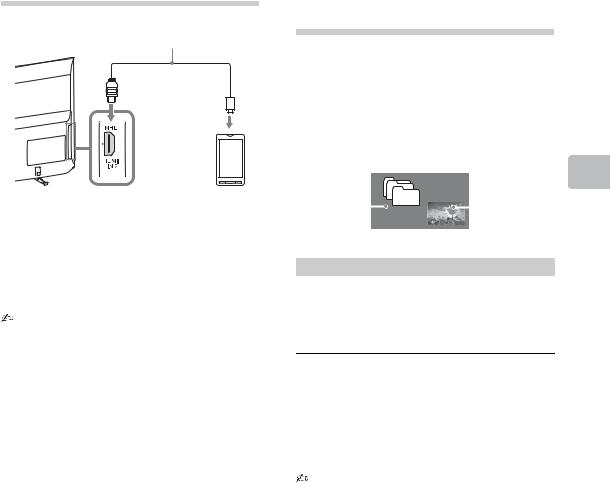
Connecting MHL device
Use authorized MHL 2 cable with
MHL logo (not supplied)
The MHL (Mobile High-Definition Link) enables the TV to communicate with connected MHL-compatible device. When connecting MHL-compatible device, TV simultaneously charges the connected device while playing photo/music/video from it. You can use the TV remote control to control the connected MHLcompatible device.
• You can continue normal usage of the connected MHL-compatible device (such as receiving calls) depending on its capability.
•Some remote control functions may not be available depending on features of the connected MHL-compatible device. Refer to the device manual for details.
•This product is officially MHL-certified for guaranteed operation with other MHL-certified devices. If you encounter any problems when using the MHL function, consult the device manufacturer for support.
•If “Auto Input Change (MHL)” is set to “On” the TV automatically switches to MHL mode when MHL-compatible device is connected to HDMI IN 2/MHL jack. The availability of “Auto Input Change (MHL)” depends on whether the MHLcompatible device can support this feature.
•The TV can connect to the MHL-compatible device via its MHL 2 connection.
Viewing PIP (Picture in Picture)
You can view two pictures (in HDMI/MHL input mode) on the screen simultaneously.
Connect a PC (page 15), and make sure that images from a PC appear on the screen (page 16).
1 Press OPTIONS and select “PIP”.
Two pictures are displayed simultaneously.
|
|
|
|
Sub Window |
|
|
|
|
|
(Location of |
|
Main |
|
the sub |
|
||
|
window can |
Using |
|||
|
|
|
|
||
Window |
|
be moved by |
|||
|
|
|
|
pressing |
|
|
|
|
|
F/f/G/g.) |
Optional |
|
|
|
|
|
|
|
PIP Availability |
||||
|
|
||||
In main window |
In sub window |
Equipment |
|||
|
|
|
|
|
|
|
|
|
IN |
||
|
|
|
TV Programme |
|
|
HDMI IN (PC timing) |
VIDEO IN |
|
COMPONENT |
||
|
2 In sub window, you can select the TV channel or video input by pressing OPTIONS and select “Sub-window”.
To return to single picture mode
Press RETURN or select “Single Picture” from Options menu.
•You cannot display resolutions higher than your TV's display resolution (page 46).
•In PIP mode, as picture size reduced, this may decrease picture smoothness.
z• You can switch the audible picture by selecting “Audio Swap” from the Options menu.
17 GB

Navigating through menus
The HOME button allows you to access a variety of TV settings and USB media files.
|
|
|
|
|
|
|
|
|
1 |
Press HOME on the TV or remote. |
|
|
|
|
|
|
|
|
|
|
|
||
|
|
|
|
|
|
|
|
|
|
||
|
|
|
|
|
|
|
|
|
2 |
Press F/f to select an option, then press |
. |
|
|
|
|
|
|
|
|
|
|||
|
|
|
|
|
|
|
|
|
|||
|
|
|
|
|
|
|
|
|
|||
|
|
|
|
|
|
|
|
|
3 |
Follow the instructions on the screen. |
|
|
|
|
|
|
|
|
|
|
|
||
|
|
|
|
|
|
|
|
|
|
||
|
|
|
|
|
|
|
|
|
|
||
|
|
|
|
|
|
|
|
|
|
||
|
|
|
|
|
|
|
|
|
4 |
To exit the menu, press HOME. |
|
|
|
|
|
|
|
|
|
|
|
||
|
|
|
|
|
|
|
|
|
|
||
|
|
|
|||||||||
Menu |
Description |
|
|||||||||
1 Digital Programme List |
You can select the Digital Programme List (page 19). |
||||||||||
|
|
||||||||||
2 Digital EPG |
You can select the Digital Electronic Programme Guide (EPG) (page 20). |
||||||||||
|
|
||||||||||
3 Photo |
You can enjoy photo files via USB devices (page 21). |
||||||||||
|
|
||||||||||
4 Music |
You can enjoy music files via USB devices (page 21). |
||||||||||
|
|
||||||||||
5 Video |
You can enjoy video files via USB devices (page 21). |
||||||||||
|
|
||||||||||
6 Photo Frame Mode |
You can select the frame image which enables you to enjoy with photo, music |
||||||||||
|
|
|
|
|
|
|
|
|
and clock (page 24) (except KDL-46R450A/40R450A/32R400A). |
||
|
|
|
|||||||||
7 FM Radio |
Listens to the FM Radio (page 26). |
|
|||||||||
|
|
||||||||||
8 Settings |
Displays the “Settings” menu where most of the advanced settings and |
||||||||||
|
|
|
|
|
|
|
|
|
adjustments are performed. For details about settings, see page 28 to 38. |
||
|
|
|
|
|
|
|
|
|
|
|
|
18 GB
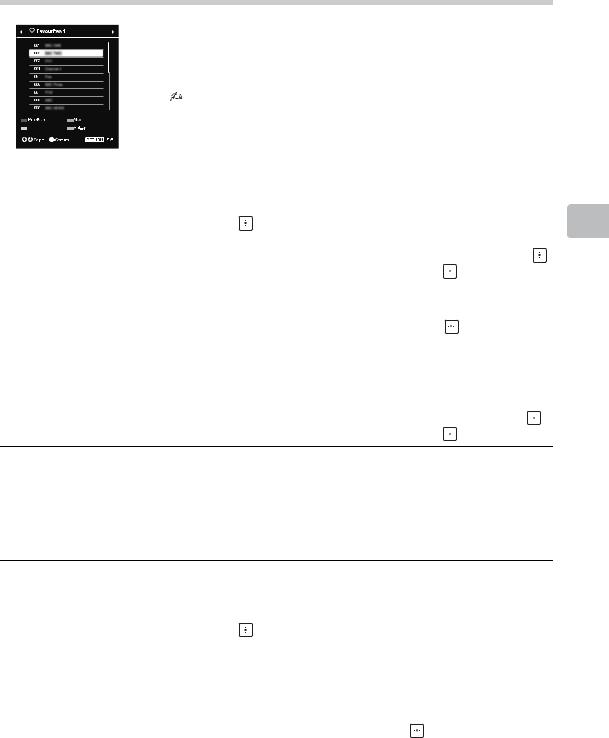
Using the Digital Programme
List  *
*
The Favourite feature allows you to specify up to four lists of your favourite programmes.
1 In digital mode, press HOME and select “Digital Programme List”, then press G/g to select the Favourite list.
• If Favourite list is already selected before, just press  to access Favourite list.
to access Favourite list.
Digital Programme List |
2 Perform the desired operation as shown in the following table or |
|
displayed on the screen. |
||
|
* This function may not be available in some countries/regions.
To |
Do this |
|
|
|
|
Create your Favourite list for the |
1 |
Press |
to select “Yes”. |
|
|
first time |
2 |
Press the yellow button to select the Favourite list. |
|
||
|
3 |
Press F/f to select the channel you want to add, then press |
. |
||
|
4 |
Press F/f to decide the position and press |
to store. |
|
|
|
5 |
Press RETURN to finish setting up. |
|
|
|
|
|
|
|
|
|
Watch a channel |
1 |
Press G/g to select the Favourite list. |
|
|
|
|
2 |
Press F/f to select the channel, then press |
. |
|
|
|
|
|
|
||
Turn off the Favourite list |
Press RETURN. |
|
|
||
|
|
|
|
|
|
Add channels in the currently |
1 |
Press the blue button to see Favourite Set-up. |
|
|
|
edited Favourites list |
2 |
Press the yellow button to select the Favourites list you want to |
|
||
|
|
edit. |
|
|
|
|
3 |
Press F/f to select the channel you want to add, the press |
. |
||
|
4 |
Press F/f to decide the position and press |
to store. |
|
|
Change the order of channels stored in the Favourites list
1Press the blue button to see Favourite Set-up.
2Press the yellow button to select the Favourites list you want to edit.
3Press  or g to jump to the Favourite list.
or g to jump to the Favourite list.
4Press F/f to select the channel you want to change the position, then press  .
.
5Press F/f to decide the position and press  to store.
to store.
Remove channels in the currently |
1 |
Press the blue button to see Favourite Set-up. |
||
edited Favourite list |
2 |
Press the yellow button to select the Favourite list you want to |
||
|
|
edit. |
|
|
|
3 |
Press g and F/f to select the channel you want to remove, then |
||
|
|
press |
. |
|
|
4 |
Press the blue button to remove. |
|
|
|
|
|
||
Remove all channels from the |
1 |
Press the blue button to see Favourite Set-up. |
||
current Favourite list |
2 |
Press the yellow button to select the Favourite list you want to |
||
|
|
edit. |
|
|
|
3 |
Press the blue button. |
|
|
|
4 |
Press G/g to select “Yes”, then press |
to confirm. |
|
|
|
|
|
|
Functions Menu Using
19 GB
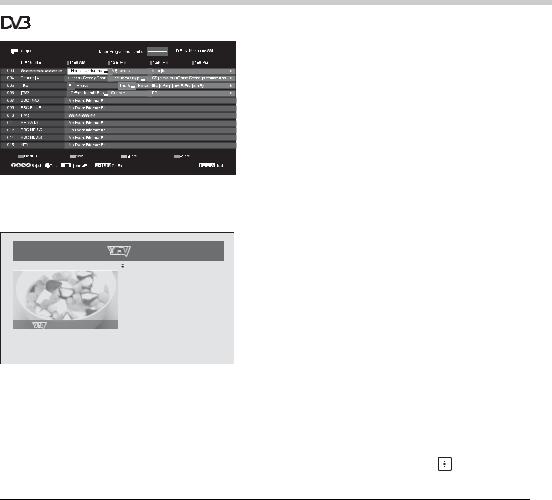
Using the Digital Electronic
Programme Guide (EPG)
1 In digital mode, press GUIDE.
2 Perform the desired operation as shown in the following table or displayed on the screen.
Digital Electronic Programme Guide (EPG)
* This function may not be available in some countries/regions.
YI-TV, 10:10am
The super actress Yukiko challenge her local specialties!
|
|
2012 .07.28 |
|
|
|
|
10.00am |
Yukiko Cooks Challenge |
|
|
|
|
11.00am |
Wizard of Writing |
|
12.00pm |
NamNam Power Lunch |
|
1.00pm |
The 183 Show |
|
3.00pm |
Midday HOT Teatime |
|
4.00pm |
Redman in the Moated |
|
|
Castle |
|
5.00pm |
YI-TV News |
|
6.00pm |
Sunset Sports |
|
7.00pm |
Northern Village Living |
|
9.00pm |
KZ BIZ NETWORK |
|
|
|
Digital Electronic Programme Guide (EPG)
~
• The contents of the screen depend on the broadcasting station.
To |
Do this |
|
|
Watch a programme |
Press F/f/G/g to select the programme or enter the desired |
|
programme number by numeric key, then press . |
|
|
Turn off the EPG |
Press GUIDE. |
~
•If an age restriction for programmes has been selected, a message asking for a PIN code will appear on the screen. For details, see “Parental Lock” on page 34.
20 GB
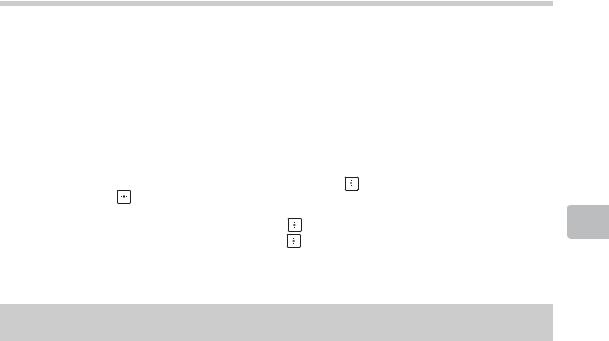
Playing back photo/music/video via USB
You can enjoy photo/music/video files stored in a Sony digital still camera or camcorder through a USB cable or USB storage device on your TV.
1 |
Connect a supported USB device to the TV. |
|
|
2 |
Press HOME. |
|
|
3 |
Press F/f to select “Photo”, “Music” or “Video”. |
|
|
4 |
The thumbnail view of file or folder appears. |
|
|
|
If more than one USB device is detected, press the red button to select “Playback Options” and then |
||
|
“Device Selection” from the list of available options and press , then press F/f/G/g to select a USB |
||
|
device and press |
. |
|
5 |
Press F/f/G/g to select a file or folder, then press |
. |
|
|
When you select a folder, select a file, then press |
. |
|
|
Playback starts. |
|
|
z• If you connect the USB device when “USB Auto Start” is set to “On” (page 36), the thumbnail view of the last played Photo/Music/Video appears automatically.
Basic operation of Photo/Music/Video
You can operate the connected USB device by the TV remote.
Item |
Description |
|
|
m / M |
Fast reverses/fast forwards the file when pressed during playback. |
|
|
. / > |
Goes to the beginning of the previous or current/next file. |
|
|
N |
Starts playback. |
|
|
X |
Pauses playback. |
|
|
x |
Stops playback. |
|
|
x To use playback options
Press the coloured buttons to display a list that contains shortcuts to some setting menus. The listed options vary depending on the current input and content.
Photo
“Slideshow Effect”: Selects an effect for a slideshow. “Slideshow Speed”: Selects the slideshow duration. “Shuffle”: Plays files in random order.
“Zoom”: Magnifies the picture (“1×”, “2×” or “4×”)
Music
“Playback Target”: Selects to play all files, or one selected file. “Shuffle”: Plays files in random order.
“Speakers”: Selects a speaker (page 30).
Video
“Playback Target”: Selects to play all files, or one selected file. “Zoom”: Magnifies the picture (“1×”, “2×”, “4×” or “Full”) “Speakers”: Selects a speaker (page 30).
Functions Menu Using
(Continued) 21 GB

General
“Repeat”: Plays a file repeatedly. “Sort By”: Changes file order
“Device Selection”: Selects a USB device.
x To set the picture (Video)
You can adjust the picture quality of USB Video.
1 Select a video.
See “Playing back photo/music/video via USB” (page 21).
2 Press OPTIONS during playback, then press F/f to select “Picture” and press  .
.
3 Press F/f/G/g to select the item, then press  .
.
4 Press F/f/G/g to adjust the setting, then press  .
.
x To play a photo as a slideshow (Photo)
You can play a slideshow with photos. “Slideshow Effect” and “Slideshow Speed” can be set.
1 Select a photo.
See “Playing back photo/music/video via USB” (page 21).
2 Press the green button in thumbnail view, or press OPTIONS while a photo is displayed, then press F/f to select “Slideshow” and press  .
.
To stop a slideshow Press RETURN or HOME.
• While the TV is accessing the data on the USB device, observe the following:
–Do not turn off the TV.
–Do not disconnect the USB cable.
–Do not remove the USB device.
The data on the USB device may be damaged.
•Sony will not be held liable for any damage to, or loss of, data on the recording media due to a malfunction of any connected devices or the TV.
•The file system on the USB device supports FAT16, FAT32 and NTFS.
•The file name and folder name may not display correctly in some cases.
•When you connect a Sony digital still camera, set the camera’s USB connection mode to Auto or Mass Storage. For more information about USB connection mode, refer to the instructions supplied with your digital camera.
•Check the website below for updated information about compatible USB devices. http://www.sony-asia.com/bravia/flash.html
•Use a USB storage device that is compliant with USB mass storage device class standards.
•If a selected file has incorrect container information, or is incomplete, it cannot be played back.
22 GB

USB Video format
Extension |
Container |
Video Codec |
Audio Codec |
|
|
|
Xvid |
PCM / MPEG1 Layer1, 2 / MP3 / |
|
|
|
|
||
|
|
MPEG1 |
MPEG2 AAC (2ch) / |
|
.avi |
AVI |
|
MPEG4 AAC (2ch) / |
|
MPEG2 MP |
||||
MPEG4 HE-AAC (2ch) / |
||||
|
|
|
||
|
|
H.264 BP/MP/HP |
WMA v8 / Dolby Digital (2ch) / |
|
|
|
|
Dolby Digital Plus (2ch) |
|
|
|
MPEG-4 SP/ASP |
||
|
|
|
||
|
|
|
|
|
|
|
WMV v9 |
|
|
|
|
|
|
|
.wmv |
ASF |
Xvid |
MP3 / WMA v8 |
|
|
||||
.asf |
MPEG-4 SP/ASP |
|||
|
|
|||
|
|
|
||
|
|
|
|
|
|
|
VC-1 |
|
|
|
|
|
|
|
.mp4 |
|
H.264 BP/MP/HP |
MPEG1 Layer1, 2 / MP3 / MPEG2 AAC / |
|
|
|
|||
|
|
|||
.mov |
MP4 |
MPEG-4 SP/ASP |
||
MPEG4 AAC / MPEG4 HE-AAC |
||||
.3gp |
|
|
||
|
H.263 |
|
||
|
|
|
||
|
|
|
|
|
|
|
H.264 BP/MP/HP |
PCM / MPEG1 Layer1, 2 / MP3 / |
|
|
|
|
MPEG2 AAC (2ch) / |
|
|
|
MPEG-4 SP/ASP |
||
.mkv |
MKV |
MPEG4 AAC (2ch) / |
||
|
||||
WMV v9 |
MPEG4 HE-AAC (2ch) / |
|||
|
|
|||
|
|
|
WMA v8 / DTS / Dolby Digital (2ch) / |
|
|
|
VC-1 |
||
|
|
Dolby Digital Plus (2ch) |
||
|
|
|
|
|
.mpg |
|
MPEG1 |
MPEG1 Layer1, 2 / MP3 / |
|
.mpeg |
|
|
||
PS |
|
Dolby Digital (2ch) / |
||
.vro |
MPEG2 MP |
|||
|
Dolby Digital Plus (2ch) / DTS |
|||
.vob |
|
|||
|
|
|
||
|
|
|
|
|
.ts |
|
MPEG2 MP |
MPEG1 Layer1, 2 / MP3 / MPEG2 AAC / |
|
TS |
|
MPEG4 AAC / MPEG4 HE-AAC/ |
||
VC-1 |
||||
.m2ts |
Dolby Digital (2ch) / |
|||
|
|
|||
|
|
H.264 BP/MP/HP |
Dolby Digital Plus (2ch) / DTS |
|
|
|
|
|
USB Music format
Extension |
Audio Codec |
.wav |
LPCM |
|
|
.mp3 |
MP3 |
|
|
.wma |
WMA v8 |
|
|
USB Photo format
Extension |
Image Codec |
.jpg, .jpeg |
JPEG |
|
|
DCF2.0 or EXIF2.21 supported.
• Playback of the above file formats is not guaranteed.
Functions Menu Using
23 GB
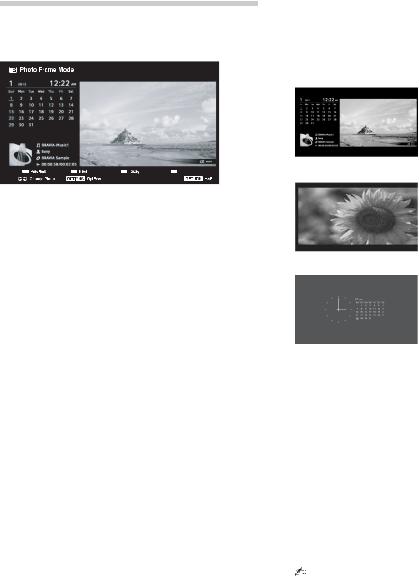
Photo Frame (except KDL46R450A/ 40R450A/ 32R400A)
You can enjoy looking at a photo, listening to music or FM radio, or the clock and calendar, at the same time.
You can enter photo frame mode using any of the following methods:
1Press HOME, and then select “Photo Frame Mode”.
2When you are playing back the photo/music files, press OPTIONS and select “Photo Frame Mode”.
3When you are listening to the FM radio, press OPTIONS and select “Photo Frame Mode”.
4Select “Image Selection”/“Music Selection” in the “Photo Frame Settings” menu.
You can switch the display mode of the frame from the Options menu, eg. image and clock, full screen image or full screen clock.
x To select photo
You can select photos from USB memory, using any of the following methods:
1Press HOME and select “Settings”, then “Set-up”
> “Photo Frame Settings” > “Image Selection”. Press  to select the file from thumbnail view.
to select the file from thumbnail view.
2In photo frame mode, press OPTIONS > “Image Selection”. Press  to select the file from thumbnail view.
to select the file from thumbnail view.
3Press HOME, and then select “Photo”. When playing back a photo, press OPTIONS > “Photo Frame Mode” to launch “Photo Frame” with the selected photo.
x To select music
You can select music from USB memory, using any of the following methods:
1Press HOME and select “Settings”, then “Set-up”
> “Photo Frame Settings” > “Music Selection”. Press  to select the file from thumbnail view.
to select the file from thumbnail view.
2In photo frame mode, press OPTIONS > “Music
Selection”.
Press  to select the file from thumbnail view.
to select the file from thumbnail view.
3Press HOME, and then select “Music”. When playing back music, press OPTIONS > “Photo Frame Mode” to launch “Photo Frame” with the selected music.
x To select Display mode
You can change the photo frame display by selecting “Display Mode” (page 35).
•Image and Clock
•Full Screen Image
•Full Screen Clock
x To select Clock Display mode
There are five calendar display modes.
When the “Display Mode” setting is set to “Image and Clock”, you can set to “Calendar”, “Analogue Clock” or “Digital Clock”. When the “Display Mode” setting is set to “Full Screen Clock”, you can set to “Calendar”, “Calendar and Clock” or “Clock”.
For more details, see page 35:
•Calendar
•Analogue Clock
•Digital Clock
•Calendar and Clock
•Clock
• This TV does not have a battery powered backup for the clock. Therefore, if there is a power failure or if you disconnect the power cord, be sure to reset the current date and time.
24 GB

x Duration
To save power, in the Photo Frame Mode, the TV can continually playing back for up to 24 hours, after which it will power off automatically. After running photo frame mode for 24 hours, not use this mode for at least one hour, to avoid panel burn-in.
You can change the setting of the “Duration” in the “Photo Frame Settings”. For details, see page 35.
To avoid panel burn-in, the position of the photo, clock and calendar are switched automatically every hour.
Functions Menu Using
25 GB
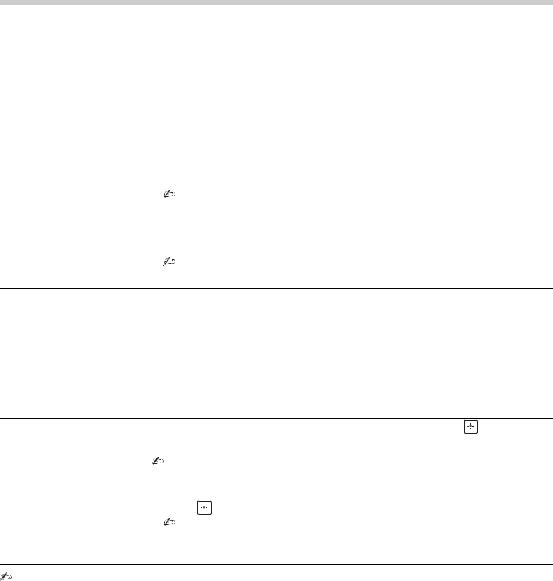
Listening to the FM Radio
You are able to listen to the FM radio stations using your TV by connecting an antenna (page 7). FM Radio tuning range is from 87.5-108.0 MHz.
When you use the FM Radio function for the first time, press HOME and select “FM Radio”, then perform “Auto Tuning” in the “FM Radio Set-up” menu (page 34).
To |
Do this |
|
|
|
|
Access to FM Radio mode |
Press HOME and select “FM Radio”. |
|
|
|
|
Exit from FM Radio mode |
Press RETURN to go back to previous view input. |
|
|
|
|
Listen to preset stations |
1 |
Access to FM Radio mode. |
|
2 |
Press HOME and select “Settings”. Preset the desired FM radio stations and |
|
|
its labels in “FM Radio Set-up” from “Channel Set-up” menu (page 34). |
|
|
• You can also access to “FM Radio Presets” by selecting “FM Radio Presets” |
|
|
from the Options menu in FM Radio mode. |
|
3 |
Exit from “Channel Set-up” menu by pressing HOME. The selected preset FM |
|
|
radio station number and label will appear on the screen. To select the |
|
|
desired preset FM radio station, press PROG +/–. |
|
|
• You can also use the 0-9 buttons on the remote to directly select the desired |
|
|
preset FM radio station. |
Listen to non-preset stations 1 Access to FM Radio mode.
2Press F/f to manually search for the desired FM radio station. It will search and stop when found the next available station.
 • You can also tune FM frequency for the desired FM radio station by pressing G/g. The available radio frequency is only for temporary listening pleasure
• You can also tune FM frequency for the desired FM radio station by pressing G/g. The available radio frequency is only for temporary listening pleasure
and cannot be stored in the memory.
•If the message “Please set-up FM Radio.” appears, display the “Channel Set-up” menu and select “FM Radio Set-up” to preset the desired FM radio stations (page 34).
Show photo frame while |
1 |
Press OPTIONS to select “Photo Frame Mode”, then press |
. |
|
listening to FM Radio |
2 |
Refer to “Photo Frame” (page 24) to select photo or “Display Mode”. |
||
(except KDL-46R450A/ |
|
• BRAVIA images will be displayed if a USB device is not connected or step 1 |
||
40R450A/32R400A) |
|
|||
|
and 2 are not performed. |
|
||
|
|
|
||
|
|
|||
Reduce power consumption 1 |
Press OPTIONS to select “Power Saving”. Select the desired options and |
|||
while in FM Radio mode |
|
press |
. |
|
|
|
• You can also access to “Power Saving” by selecting “Eco” from the setting |
||
|
|
menu (page 38). |
|
|
|
2 |
Exit from “Picture Off” by pressing any key on the remote except 2 +/– or %. |
||
• If the station has a noisy sound, you may be able to improve the sound quality by pressing G/g.
•When an FM stereo programme has static noise, press AUDIO until “Mono” appears. There will be no stereo effect, but the noise will be reduced.
•If CATV is connected, FM Radio may not be able to be received.
26 GB

Using BRAVIA Sync with
BRAVIA Sync Control
The BRAVIA Sync Control function enables the TV to communicate with the connected equipment that is compatible with the function, using HDMI CEC (Consumer Electronics Control). For example, by connecting Sony equipment that is compatible with BRAVIA Sync Control (with HDMI/MHL cables), you can control them together.
Be sure to connect the equipment correctly, and make the necessary settings.
BRAVIA Sync Control
•Automatically turns the connected equipment off when you switch the TV to standby mode using the remote.
•Automatically turns the TV on and switches the input to the connected equipment when the equipment starts to play (except in MHL mode).
•If you turn on a connected audio system while the TV is on, the sound output switches from the TV speaker to the audio system.
•Adjusts the volume (2 +/–) or mutes the sound (%) of a connected audio system.
•You can operate the connected Sony equipment that has the BRAVIA Sync logo by the TV remote. Possible operations with BRAVIA Sync buttons, see page 12.
–Refer to the instruction manual of the equipment for available control.
•If “BRAVIA Sync Control” of the TV is set to “On”, “BRAVIA Sync Control” of the connected equipment is also automatically switched to “On”.
x To make the BRAVIA Sync Control settings
The BRAVIA Sync Control settings must be set on both the TV side and connected equipment side. See “BRAVIA Sync Settings” (page 37) for the TV side settings. For settings on the connected equipment, refer to its operating instructions.
Functions Menu Using
27 GB

Settings adjustment
• The options you can adjust vary depending on the situation. Unavailable options are greyed out or not displayed.
 Picture
Picture
Picture Mode |
Sets a picture mode. The options that can be selected differ depending on the |
|
“Scene Select” settings. |
|
“Vivid”: Enhances picture contrast and sharpness. |
|
“Standard”: For standard pictures. Recommended for home entertainment. |
|
“Custom”: Allows you to store your preferred settings. |
|
“Cinema”: For film-based content. Suitable in a theatre-like environment. |
|
“Graphics”: Optimizes picture quality for viewing graphics. |
|
Scene Select mode |
|
Press OPTIONS and select “Scene Select” menu. When you select the desired |
|
scene option, the optimum sound and picture quality for selected scene are |
|
automatically set. The options you can select may vary. Unavailable options |
|
are greyed out. |
|
“Auto”: Delivers optimum picture and sound quality which is automatically set |
|
according to input source. There may not be any effect depending on the |
|
connected equipments. |
|
“General”: Current user settings. |
|
“Music”: Delivers dynamic and clear sound effects like at a concert. |
|
“Cinema”: Delivers theatre-like picture and dynamic sound. |
|
“Game”: Delivers the best picture and sound quality for fullest game playing |
|
enjoyment. |
|
“Graphics”: Delivers clearer detailed pictures to reduce fatigue for prolonged |
|
viewing. |
|
“Sports”: Delivers realistic picture with surround sound like in a stadium. |
|
|
Reset |
Resets all the “Picture” settings except “Picture Mode” to the factory settings. |
|
|
Backlight |
Adjusts the brightness of the backlight. |
|
|
Picture |
Increases or decreases picture contrast. |
|
|
Brightness |
Brightens or darkens the picture. |
|
|
Colour |
Increases or decreases colour intensity. |
|
|
Hue |
Increases or decreases the green tones and red tones. |
|
• When viewing TV programme or video input, “Hue” is only available for NTSC |
|
colour system. |
|
|
Sharpness |
Sharpens or softens the picture. |
|
|
Colour Temperature |
Adjusts the whiteness of the picture. |
|
“Cool”: Gives the white colours a blue tint. |
|
“Neutral”: Gives the white colours a neutral tint. |
|
“Warm”: Gives the white colours a red tint. |
|
|
Noise Reduction |
Reduces the picture noise (snowy picture) in a weak broadcast signal. |
|
|
MPEG Noise |
Reduces the picture noise in MPEG-compressed video. |
Reduction |
|
|
|
Cinema Drive |
Provides improved picture movement when playing BD (Blu-ray Disc), DVD or |
|
VCR images taken on film, reducing picture blur and graininess. Select “Auto” |
|
to represent original film-based content as is. |
|
• If the image contains irregular signals or too much noise, “Cinema Drive” is |
|
automatically turned off even if “Auto” is selected. |
|
|
28 GB
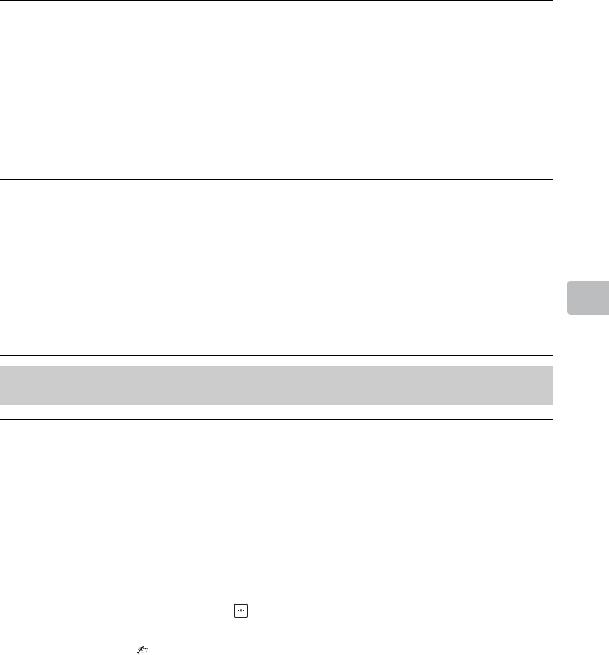
Advanced Settings Allows you to set “Picture” settings in more detail. These settings are not available when “Picture Mode” is set to “Vivid”.
“Reset”: Resets all the advanced settings to the factory settings.
“Adv. Contrast Enhancer”: Automatically adjusts “Backlight” and “Picture” to the most suitable settings judging from the brightness of the screen. This setting is especially effective for dark images scenes, and will increase the contrast distinction of the darker picture scenes.
“Black Corrector”: Enhances black areas of the picture for stronger contrast. “Gamma”: Adjusts the balance between bright and dark areas of the picture. “Clear White”: Emphasises white colours.
“Live Colour”: Makes colours more vivid.
“LED Motion Mode”: Reduces blur in movies by controlling the LED backlight source, but the brightness decreases.
Intelligent Picture
Plus Set-up
“Intelligent Picture Plus”
Allows you to improve the picture when viewing TV programme or video input. The options that can be selected differ depending on the “Scene Select” settings.
“Signal Level Indicator”
Turns on/off the “Signal Level Indicator” feature. When “On” is selected, the signal level bar will be displayed when you select a channel or video input.
“Picture Optimisation”
Allows you to enhance the picture to your preferred settings. “Crisp”: For a sharper image with more visible noise. “Smooth”: For a softer image with less visible noise.

 Sound
Sound
Sound Mode |
Sets a sound mode. |
|
|
“Standard”: For standard sound. |
|
|
“Music”: Delivers surround effects that make you feel like you are surrounded |
|
|
by sound as in a music hall. |
|
|
“Cinema”: Delivers surround effects just like the high-grade audio systems |
|
|
found in movie theatres. |
|
|
“Game”: Delivers surround effects that enhance game sound. |
|
|
“Sports”: Delivers surround effects that make you feel like you are watching a |
|
|
live sports contest. |
|
|
|
|
Reset |
Resets all the “Sound” settings except “Sound Mode”, “Dual Sound”, |
|
|
“Speakers”, “Audio Out” and “Advanced Settings” to the factory settings. |
|
|
|
|
Equaliser |
Adjusts sound frequency settings. |
|
|
Press G/g to select the desired sound frequency, then press F/f to adjust the |
|
|
setting and press |
. The adjusted settings will be received when you select |
|
“Sound Mode” options. |
|
Selecting “Reset” will set the “Equaliser” to original settings. |
|
• Adjusting higher frequency will affect higher pitched sound and adjusting lower |
|
frequency will affect lower pitched sound. |
|
|
Sound Booster |
Produces a fuller sound for more impact, by emphasising the bass sounds. |
|
|
Clear Voice |
Makes voice sound clearer. |
|
|
Simulated Stereo |
Adds a surround-like effect to mono programmes. |
|
|
Intelligent Volume |
Minimizes the difference in volume level between all programmes and adverts |
|
(e.g. adverts tend to be louder than programmes). |
|
|
Balance |
Emphasises left or right speaker balance. |
|
|
Volume Offset |
Adjusts the volume level of the current input relative to other inputs. |
|
|
Functions Menu Using
(Continued) 29 GB
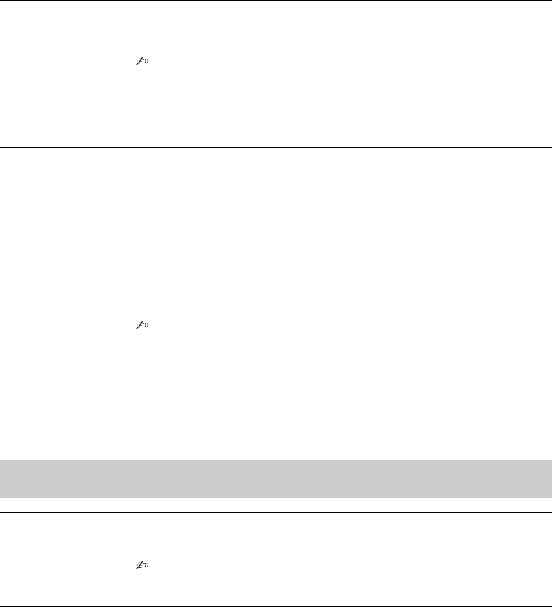
Dual Sound |
Sets the sound from the speaker for a stereo or bilingual broadcast. |
|
“Stereo”/“Mono”: For stereo broadcasts. |
|
“Main”/“Sub”/“Mono”: For bilingual broadcasts, select “Main” for sound |
|
channel 1, “Sub” for sound channel 2, or “Mono” for mono channel, if available. |
|
• If the signal is very weak, the sound becomes monaural automatically. |
•If the stereo sound is noisy when receiving a NICAM programme, select “Mono”. The sound becomes monaural, but the noise is reduced.
•The “Dual Sound” setting is memorized for each programme position.
•You cannot listen to stereo broadcast sound when “Mono” is selected.
z• If you select other equipment connected to the TV, set “Dual Sound” to “Stereo”, “Main” or “Sub”. However, when the external equipment connected to the HDMI jack (except HDMI 1) is selected, this is fixed to “Stereo”.
Speakers |
“TV Speakers”: Turns on and outputs the TV’s sound from the TV speakers. |
|
|
“Audio System”: Turns off the TV speakers and outputs the TV’s sound from |
|
|
external audio equipment connected to the audio output jacks on the TV. |
|
|
You can also turn on the connected equipment that is compatible with BRAVIA |
|
|
Sync Control, after making the appropriate settings of BRAVIA Sync Control. |
|
|
|
|
Audio Out |
“Variable”: When using an external audio system, volume output from audio |
|
|
out can be controlled using the TV’s remote. |
|
|
“Fixed”: The audio output of the TV is fixed. Use your audio receiver’s volume |
|
|
control to adjust the volume (and other audio settings) through your audio |
|
|
system. |
|
|
|
|
Advanced Settings |
“Dynamic Range”: Compensates for differences in the audio level between |
|
|
different channels (only for Dolby Digital audio). |
|
|
|
• The effect may not function or may vary depending on the programme regardless |
|
|
of the “Dynamic Range” setting. |
|
“Digital Audio Out”: Sets the audio signal that is output from the DIGITAL |
|
|
AUDIO OUT (OPTICAL) jack of the TV. Set to “Auto”, when connecting |
|
|
equipment compatible with Dolby Digital. Set to “PCM”, when connecting |
|
|
equipment not compatible with Dolby Digital. |
|
|
“Downmix Mode”: Set the downmix method of multi-channel to two-channel |
|
|
sound. |
|
|
• |
“Surround”: Select to get best surround performance. |
|
• |
“Stereo”: Select to get a stereo output. |
|
|
|
 Screen
Screen
Wide Mode |
For details about wide mode, see page 13. |
Auto Wide |
Automatically changes the wide mode according to the input signal from an |
|
external equipment. To keep your setting, select “Off”. |
|
• “Auto Wide” is only available when watching programmes from video input, HDMI/ |
|
MHL and component input in format 480i or 576i. |
z• Even if “Auto Wide” is set to “On” or “Off”, you can always modify the format of the screen by pressing  repeatedly.
repeatedly.
4:3 Default |
Selects the default screen mode for use with 4:3 broadcasts. |
|
“Wide Zoom”: Enlarges the 4:3 picture to fill the 16:9 screen, keeping the original |
|
image as much as possible. |
|
“Normal”: Displays conventional 4:3 broadcasts in the correct proportions. |
|
“Off”: Keeps the current “Wide Mode” setting when the channel or input is |
|
changed. |
|
|
Auto Display Area |
“On”: Automatically adjusts the display area based upon the content. |
|
“Off”: Turns off the “Auto Display Area”. Choose one from the “Display Area” |
|
options. |
|
|
30 GB
